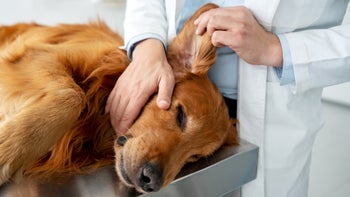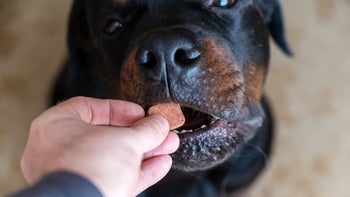
Phenobarbital for Dogs: Uses, Side Effects, And How It Works to Treat Seizures
Key takeaways:
Phenobarbital is a relatively safe and well-tolerated treatment option for dogs with seizures. But your dog will need to have regular blood tests while taking this medication.
Any phenobarbital side effects your dog experiences, such as increased appetite and thirst, will likely go away after a few weeks.
Phenobarbital can interact with other medications, such as certain antibiotics and antihistamines. Make sure you talk to your vet about your pet’s medications before giving them phenobarbital.
Table of contents

In dogs, a single seizure that passes quickly usually isn’t dangerous. But multiple episodes or very long-lasting seizures can be. If your pet has an average of two or more seizures per month, has a seizure that lasts longer than 5 minutes, or experiences a series of seizures within a single day, your vet will most likely prescribe them medication.
While there are a few options, phenobarbital is a common first-choice option for treating seizure conditions in dogs. Below, learn more about phenobarbital, including how it works, its side effects, and what medications it interacts with.
Phenobarbital for dogs at a glance
Common names | Phenobarbital |
What it treats | Seizures |
How it comes (forms) | Tablet, oral liquid, injection |
Dosage | Depends on your dog’s weight |
Common side effects | Increased appetite, increased thirst, weight gain, increased urination |
Average cost |

What is phenobarbital used for in dogs, and how does it work?
Phenobarbital is a prescription antiseizure medication that is available as a tablet, oral liquid, and injection. Phenobarbital is used to treat seizures and epilepsy in dogs.
Save on the top 10 pet medications
Save big on common pet medications like Fluoxetine and Levetiracetam at your local pharmacy.

GoodRx is NOT insurance. GoodRx Health information and resources are reviewed by our editorial staff with medical and healthcare policy and pricing experience. See our editorial policy for more detail. We also provide access to services offered by GoodRx and our partners when we think these services might be useful to our visitors. We may receive compensation when a user decides to leverage these services, but making them available does not influence the medical content our editorial staff provides.
Veterinarians use phenobarbital as an off-label medication since it is not FDA-approved for use in dogs. Phenobarbital controls the electrical brain activity that happens during a seizure, helping to lower the number and severity of episodes.
Phenobarbital is a controlled substance, meaning there are more restrictions regarding how your pet’s prescription can be filled at the pharmacy. These restrictions may include:
Limits on the number of refills
Amount of medication you can fill at once
How long the prescription is valid
The regulations vary from state to state, so check with your local pharmacy for details.
How is phenobarbital given to dogs?
Pet owners can fill a prescription for the oral tablets at any pharmacy, including human and pet pharmacies. Some pet pharmacies offer compounded forms — such as pastes, oral liquids, or chewable tablets — for dogs who have issues swallowing pills.
You can give your dog phenobarbital with or without food. It should start working to fully control their seizures within a few weeks. But you may begin to notice some improvement sooner. It’s important not to suddenly stop giving your dog phenobarbital. Stopping suddenly can lead to increased seizures again.
Understanding dog seizures: Learn how to recognize signs that your dog may be having a seizure and what to do if it happens.
Paying for dog epilepsy: Caring for a dog with a chronic condition such as epilepsy can be expensive. Read how one dog owner managed the costs for her pup’s medications.
Human medicines for pets: Your dog can take some of the same medications as humans, including phenobarbital. Here’s how to fill these prescriptions for your pet.
If needed, phenobarbital can be used in combination with other seizure medications. In a clinic or hospital, phenobarbital may be given as an injection.
How is a phenobarbital dosage determined for dogs?
Your veterinarian will determine your dog’s phenobarbital dosage based on their weight and the number and severity of seizures they’ve been having. Typically, phenobarbital is started at a dosage of 2.5 mg per kilogram of body weight every 12 hours. Depending on how your dog responds, their dosage may be raised or lowered.
What are the side effects of phenobarbital in dogs?
Phenobarbital is generally well tolerated once your pet adjusts to the medication. Your dog may seem more tired than usual or uncoordinated when first starting phenobarbital or if their dosage is raised.
Read more like this
Explore these related articles, suggested for readers like you.
Some dogs, however, experience the opposite effect and may appear more restless or nervous. You may notice them pacing around the room, panting, and whining.
Other common side effects of phenobarbital in dogs include:
Increased appetite
Increased thirst
Increased urination
Weight gain (typically caused by eating more food)
These effects are usually temporary and get better or go away within a few weeks after your dog starts treatment. If your pet still seems very sleepy or uncoordinated after taking phenobarbital for 2 weeks, talk to your vet, as they may need to lower the dosage.
Does my dog need to be monitored while taking phenobarbital?
Yes, your veterinarian will regularly test your dog’s blood to check their phenobarbital levels. The ideal phenobarbital blood level is between 15 μg/mL and 35 μg/mL. If a test shows higher or lower levels of the medication, your vet may change your dog’s phenobarbital dosage and retest them 2 weeks later.
Your dog’s liver health and red blood cell count will also be checked to monitor for the serious side effects discussed below. These blood tests will be done more often when your dog first starts taking phenobarbital. Once they are taking a steady dosage and responding well, the test will be done every 6 months.
What are the most serious risks of phenobarbital for dogs?
In rare cases, dogs can experience serious risks while they’re on phenobarbital. Dogs can develop anemia (low red blood cell count) or have a sudden change in liver health while taking phenobarbital. These are serious side effects.
If your dog has yellowing of the skin or eyes and is vomiting, contact your vet or go to an emergency animal hospital right away. These are signs of possible liver damage that need immediate medical care.
Before prescribing phenobarbital, your vet may perform blood tests to check your dog’s liver and kidney health. Vets do not typically prescribe phenobarbital to dogs with known liver, kidney, or breathing problems. The medication can worsen these conditions or cause dangerous side effects.
Phenobarbital toxicity in dogs
Phenobarbital toxicity can occur in dogs who take the medication for a long time or end up with too much in their blood. This is why veterinarians will check your dog’s blood work regularly while they’re taking the medication.
Phenobarbital toxicity most often damages your dog’s liver, causing symptoms such as:
Buildup of extra fluid in the abdomen
Sedation
Loss of coordination
Yellowing of the eye whites, gums, or skin (jaundice)
Discolored urine
If you believe that your dog received too much medication, contact your veterinarian, an emergency animal clinic, or a pet poison hotline.
Does phenobarbital interact with any other dog medications?
Yes, phenobarbital interacts with many medications. Use phenobarbital with caution if your pet is taking any of the following:
Antibiotics, such as metronidazole and doxycycline
Antihistamines, such as diphenhydramine or cetirizine
Cannabidiol (CBD)
Estrogens
Many heart medications
Amitraz (found in some tick medications)
These are not the only potential medication interactions for phenobarbital. Be sure to provide your vet with a complete list of all medications and supplements your dog takes before they start treatment. This will help your vet avoid potential interactions.
What should you do if your dog misses a dose of phenobarbital?
If you forget to give your dog a dose and it’s almost time for their next one, give the next dose early. Then gradually shift back to your dog’s usual schedule. Do your best not to miss any phenobarbital doses, because being late can make their seizures come back.
Being consistent with your dog’s phenobarbital doses is very important, as missing even one dose can potentially trigger a seizure.
What should you do if your dog continues to have seizures while taking phenobarbital?
Contact your veterinarian immediately if your dog continues to have seizures after taking phenobarbital for 2 weeks. Seizures after this point may mean that the dosage is not right or your dog needs a different medication.
Always contact your veterinarian if your dog has two or more seizures in a day or a seizure that lasts for more than 5 minutes. This could be an emergency.
Your veterinarian may recommend that you give your pet an additional dose after a breakthrough seizure, but you should only do this if your vet instructs you to. Giving your dog an extra dose on your own could be harmful to them.
It is helpful to keep a diary in which you record the length of your dog’s seizures, their symptoms, and what happens right before and after their seizures occur. Consider taking a video of your dog when they have a seizure to share with the vet. This extra information may help your vet decide the next steps for treating your dog’s seizures.
Frequently asked questions
No, you cannot get phenobarbital for your dog without a veterinarian’s prescription. Phenobarbital is a prescription-only medication. It is also a Schedule IV controlled substance in the U.S., so you need to follow extra guidelines to fill the prescription for your dog.
Phenobarbital can take several weeks to work really well for dogs. But most dogs’ seizures will start to improve as soon as they start the medication.
Yes, dogs can take phenobarbital and Keppra (levetiracetam) at the same time. Your veterinarian may suggest this if your dog’s seizures aren’t managed well enough with one medication alone.
The bottom line
Phenobarbital is an anticonvulsant that can prevent seizures in dogs. It is generally well tolerated and a common first-choice treatment option. But there are side effects to watch out for, such as sedation and a lack of coordination, as well as several medication interactions.
Give your dog phenobarbital as instructed, and take your pup for any ordered blood tests on time. Be sure to keep a log of your dog’s seizures, and speak to your veterinarian if you have any concerns about how phenobarbital is affecting your dog.
Why trust our experts?



References
Akin, E. Y. (2020). Treatment plans for routine and refractory canine epilepsy. Today’s Veterinary Practice.
Brooks, W. (2024). Phenobarbital. Veterinary Partner.
Merck Veterinary Manual. (n.d.). Systemic pharmacotherapeutics of the nervous system.
Podell, M., et al. (2016). 2015 ACVIM small animal consensus statement on seizure management in dogs. Journal of Veterinary Internal Medicine.
Rossmeisl Jr., J. H. (2015). Phenobarbital. Plumb’s Therapeutics Brief.
U.S. Department of Justice. (2024). Controlled substances: Alphabetical order.



























